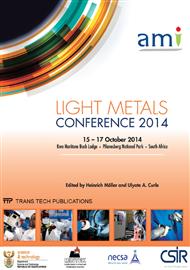p.280
p.287
p.294
p.302
p.311
p.318
p.327
p.333
p.339
Alpha Case Characterization of Hot Rolled Titanium
Abstract:
Titanium alloys offer excellent corrosion resistance, good strength to weight ratio, is nonmagnetic and biocompatible. This allows them to be used in demanding applications and specialised industries ranging from aviation to medicine. However, at high temperatures the metal is chemically reactive which requires several manufacturing processes such as melting and welding to be performed either in vacuum or inert gas atmosphere. Some processes such as rolling are impractical to be performed in inert gas atmosphere. Titanium alloys, notably Ti-6Al-4V, develops a hard oxide layer on the outer surface during hot processing, such as rolling, in atmospheric conditions. This oxide layer, commonly referred to as the alpha case, is both hard and brittle. The increased Young's modulus of the alpha case creating an outer layer with increased stiffness where maximum stresses occur, results in localized micro failure. The micro failures in this layer serve as a fatigue crack initiation zone, compromising the integrity of the component and causing it to fail. Traditionally alpha case is removed by means of chemical milling in hot acid baths using aggressive acids such as Hydrofluoric acid. The facilities needed for chemical milling require high capital costs as well as stringent and costly safety requirements. Lastly, the disposal of used acids is proving to become increasingly difficult due to the strict South African environmental laws. Removal of this layer by means of light pass machining has therefore become more desirable, however at present it remains economically infeasible. This study presents an overview of the materials background, alpha case formation and related machining considerations. Experiments that investigate alpha case properties are included.
Info:
Periodical:
Pages:
311-317
Citation:
Online since:
October 2014
Authors:
Keywords:
Price:
Сopyright:
© 2014 Trans Tech Publications Ltd. All Rights Reserved
Share:
Citation:


